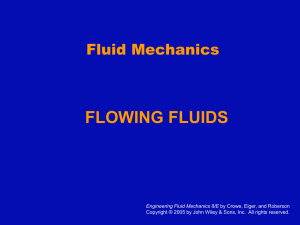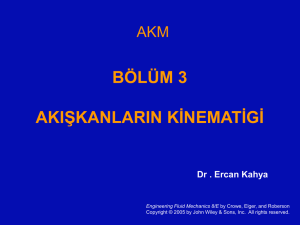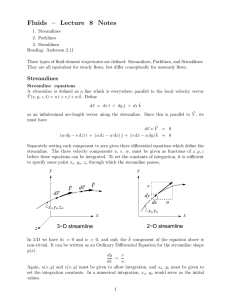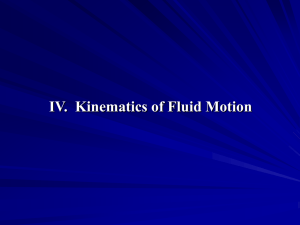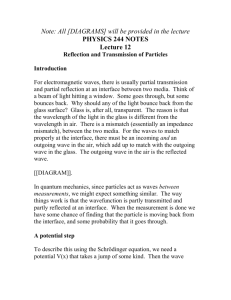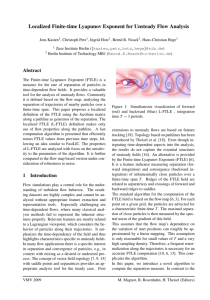The coordinates of particles A, B, C and D are (0,0), (0,1), (1,0), and
advertisement
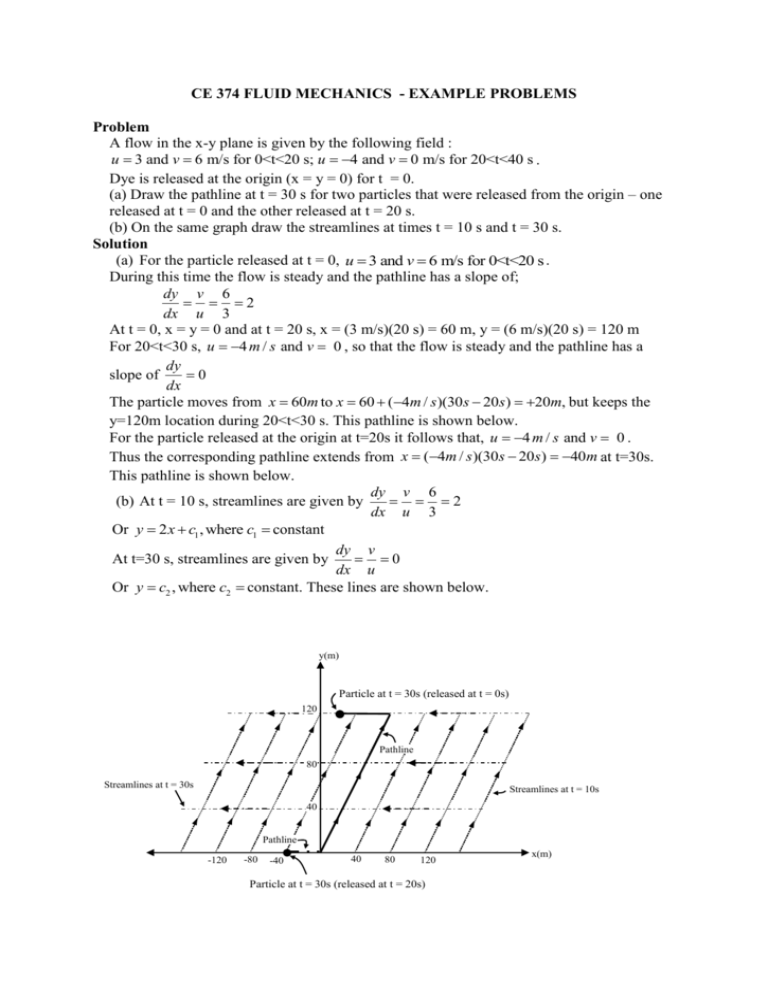
CE 374 FLUID MECHANICS - EXAMPLE PROBLEMS Problem A flow in the x-y plane is given by the following field : u 3 and v 6 m/s for 0<t<20 s; u 4 and v 0 m/s for 20<t<40 s . Dye is released at the origin (x = y = 0) for t = 0. (a) Draw the pathline at t = 30 s for two particles that were released from the origin – one released at t = 0 and the other released at t = 20 s. (b) On the same graph draw the streamlines at times t = 10 s and t = 30 s. Solution (a) For the particle released at t = 0, u 3 and v 6 m/s for 0<t<20 s . During this time the flow is steady and the pathline has a slope of; dy v 6 2 dx u 3 At t = 0, x = y = 0 and at t = 20 s, x = (3 m/s)(20 s) = 60 m, y = (6 m/s)(20 s) = 120 m For 20<t<30 s, u 4 m / s and v 0 , so that the flow is steady and the pathline has a dy 0 slope of dx The particle moves from x 60m to x 60 (4m / s)(30s 20s) 20m, but keeps the y=120m location during 20<t<30 s. This pathline is shown below. For the particle released at the origin at t=20s it follows that, u 4 m / s and v 0 . Thus the corresponding pathline extends from x (4m / s)(30s 20s) 40m at t=30s. This pathline is shown below. dy v 6 2 (b) At t = 10 s, streamlines are given by dx u 3 Or y 2 x c1 , where c1 constant dy v 0 At t=30 s, streamlines are given by dx u Or y c2 , where c2 constant. These lines are shown below. y(m) Particle at t = 30s (released at t = 0s) 120 Pathline 80 Streamlines at t = 30s Streamlines at t = 10s 40 x Pathline -120 -80 -40 40 80 120 Particle at t = 30s (released at t = 20s) x(m) Problem: A two-dimensional velocity field is given by u = x(1+2t), v = y. (a) Find the equation of the time-varying streamlines which all pass through the point (xo,yo) at some time t. Sketch some of them. (b) Find the equation of the pathline that passes through (xo,yo) at time t=0. Sketch it. Solution: (a) dx dy dz dr u v w V Integrate holding t constant. ln x ln y C 1 2t dx dy x 1 2t y t=-0.4 y Cx1/ 1 2 t t=-0.2 t=0 y t=1.0 yo t=2.0 1 / 1 2 t If y = yo at x = xo, y o Cx o C 1 / 1 2 t yo 1 / 1 2 t xo y x y 1/ 1o2 t x1 / 1 2 t yo xo x o xo x Some streamlines are sketched in the figure. (b) u dx / dt x /(1 2t ) dx / x (1 2t )dt ln x t t 2 C1 x exp(t t 2 C1 ) (C2 ) exp(t t 2 ) At x x0 and t 0, x0 e0C2 , C2 x0 ; x x0 exp(t t 2 ), v dy / dt y, dy / y dt , ln y t C3 , y exp(t C3 ) et C4 . At y y0 and t 0, y0 e0C4 , C4 y0 ; y y0 et , t ln( y / y0 ), x x0 exp(t t 2 ) x0 exp(ln( y / y0 ) ln 2 ( y / y0 )). The pathline is sketched in the figure below. y t=0.25 y0 t=0 t=-0.5 t=-1.0 t=-1.5 x0 x Problem: The coordinates of particles A, B, C and D are (0,0), (0,1), (1,0), and (1,1), respectively, at 1 t=0 as shown in the scetch below. If the velocity is V i j , find the coordinates x describing the positions of these particles at t=2 s. Show the new location of the particles. Based on the old and new location of the particles explain if a) the fluid is incompressible, b) the flow is irrotational and c) the flow is inviscid of not. (Hint: Find the pathlines first!) y 4 3 2 1 0 B D A C 0 1 2 3 4 x
